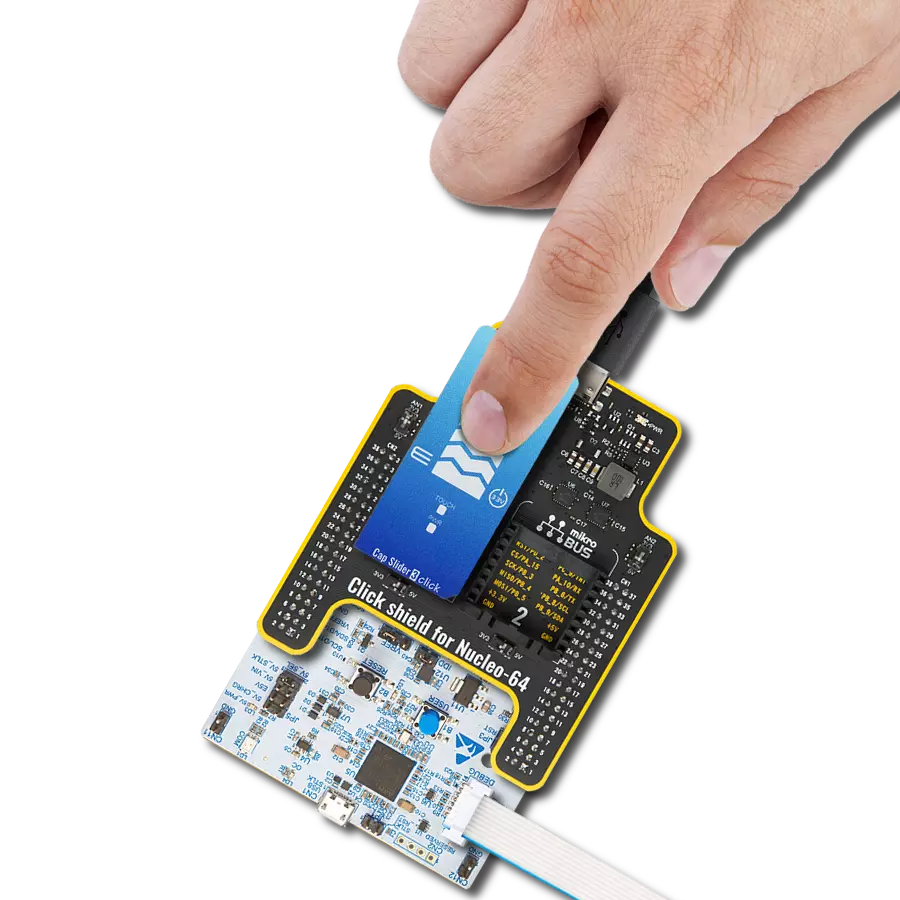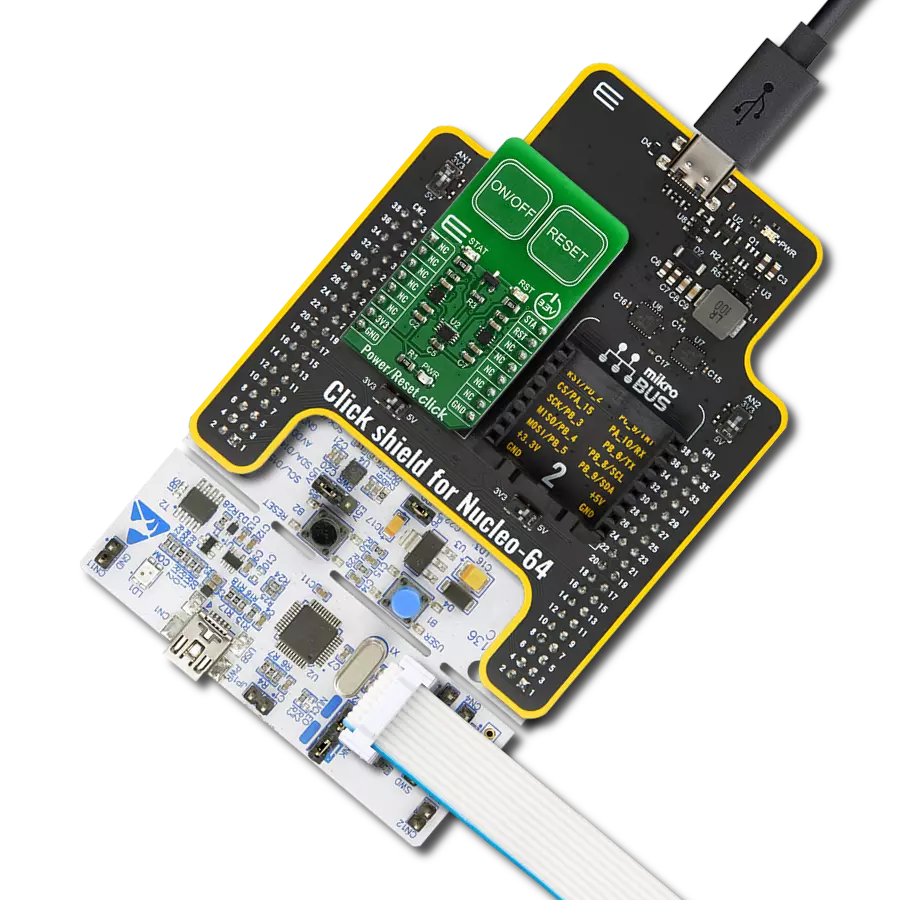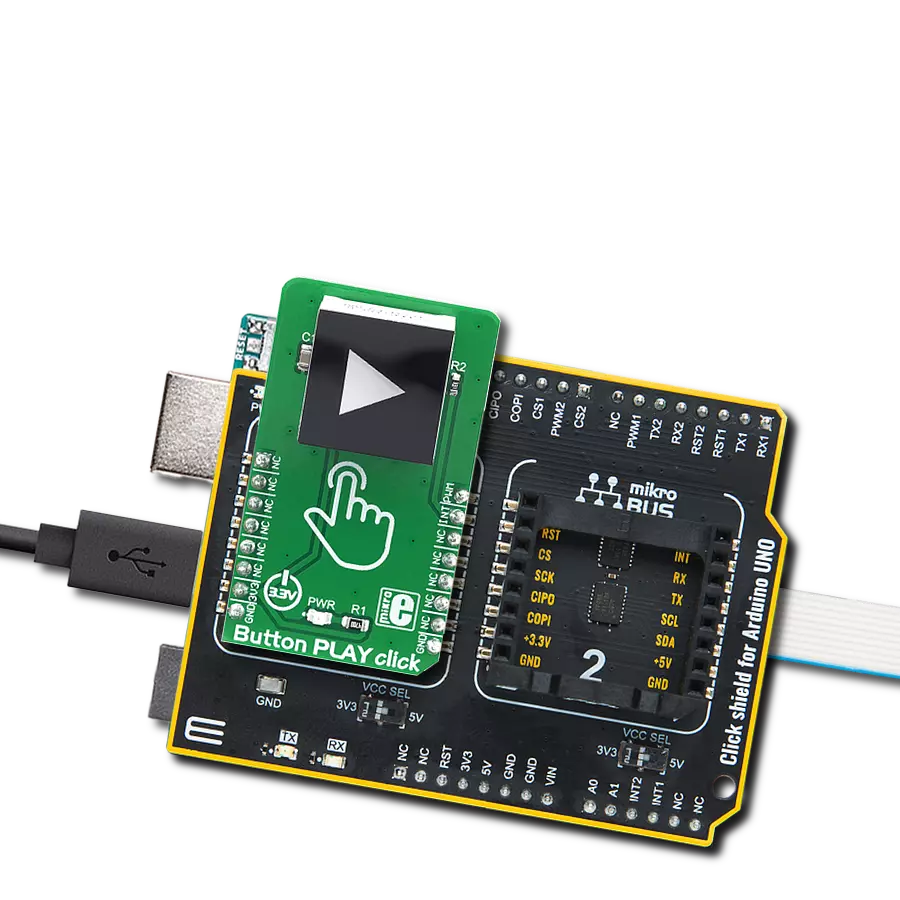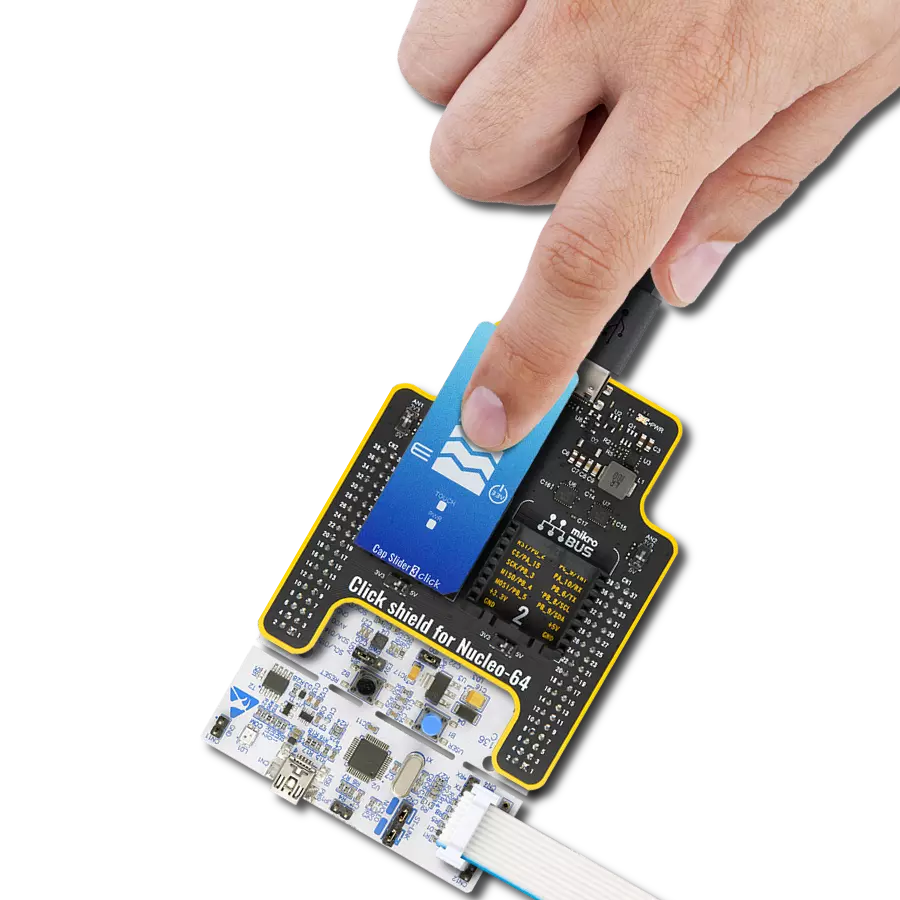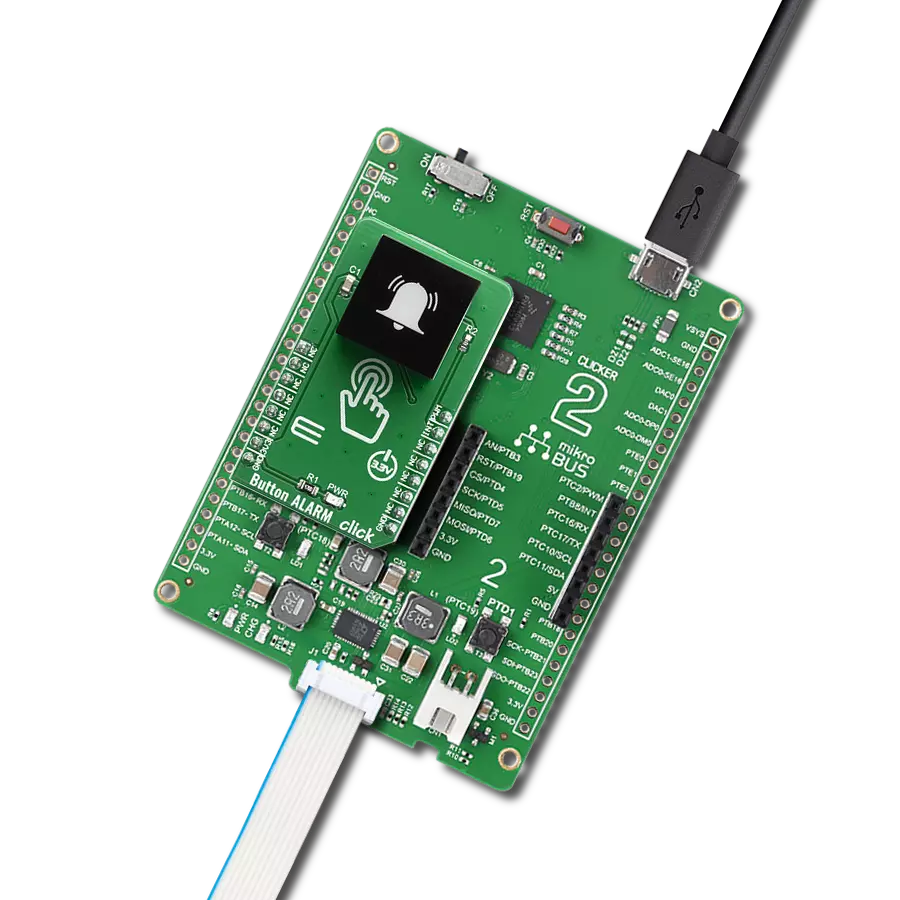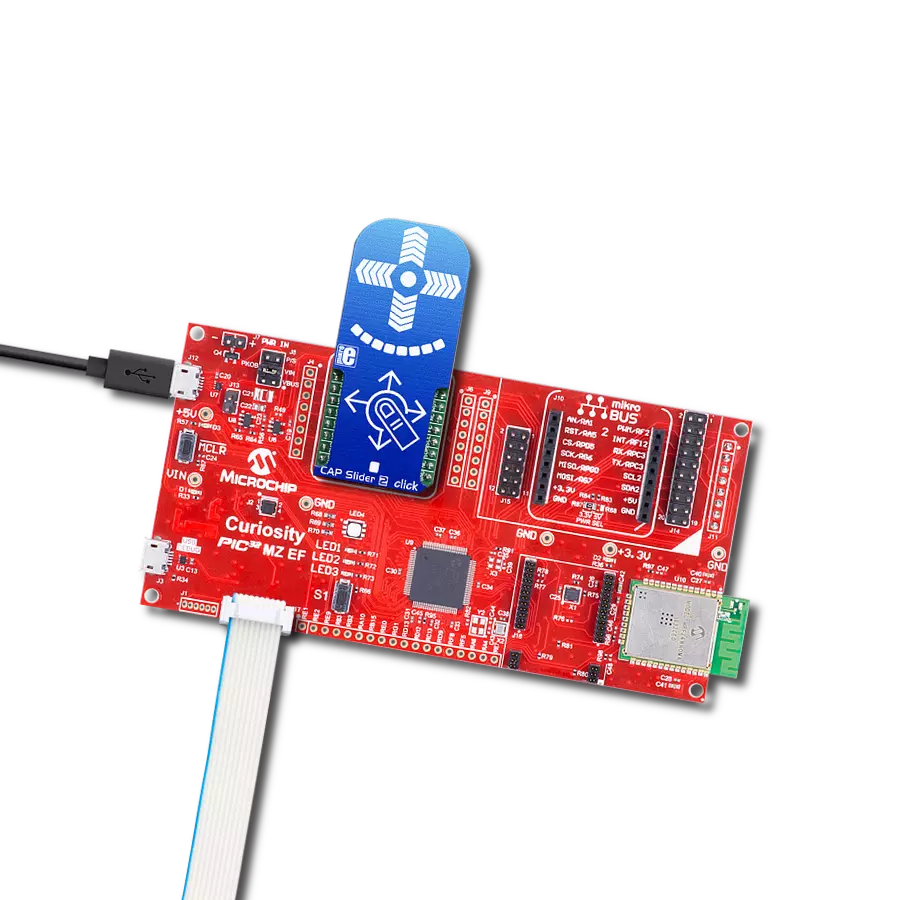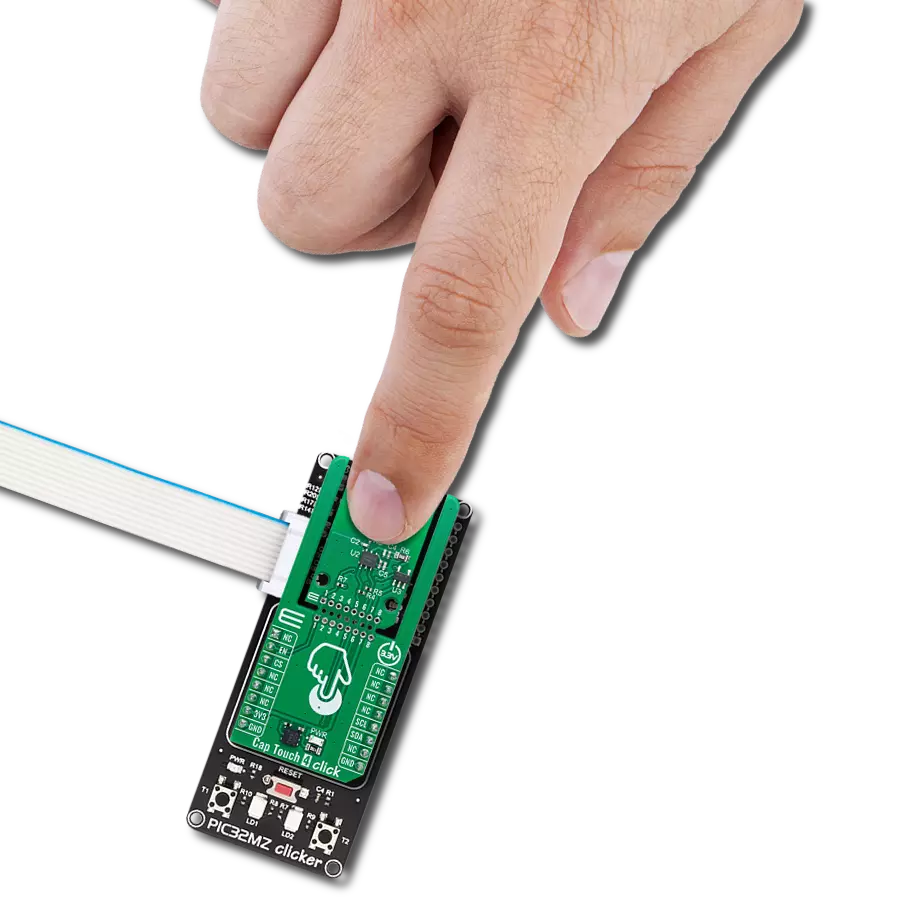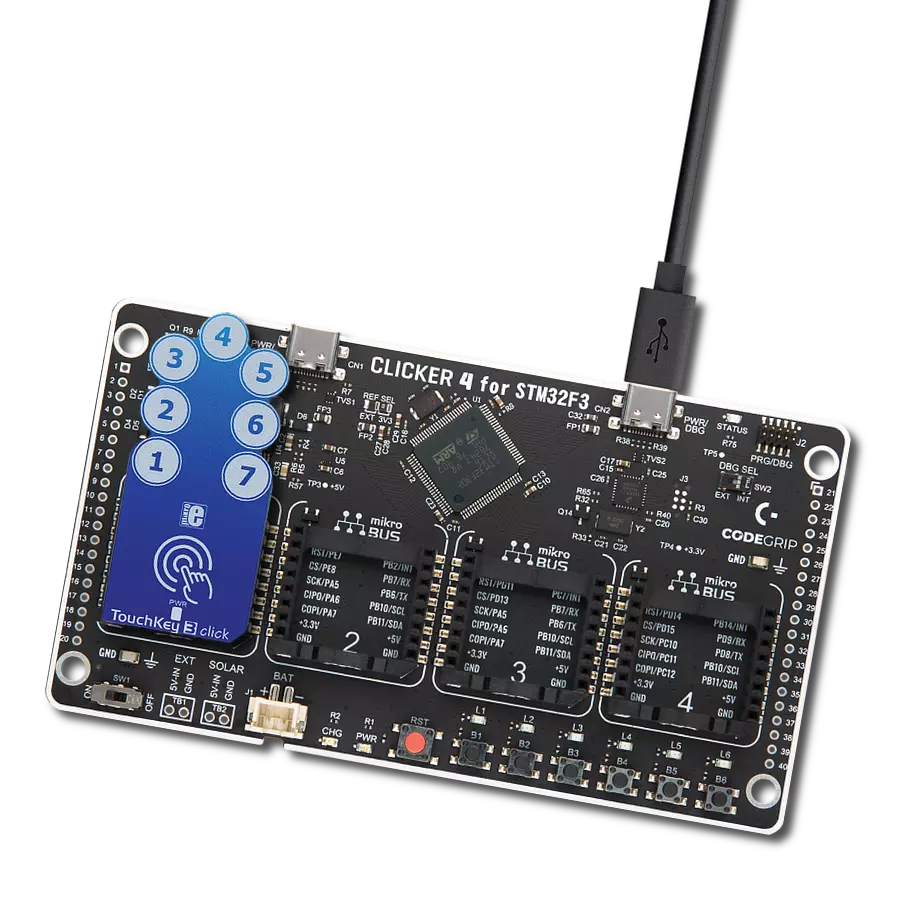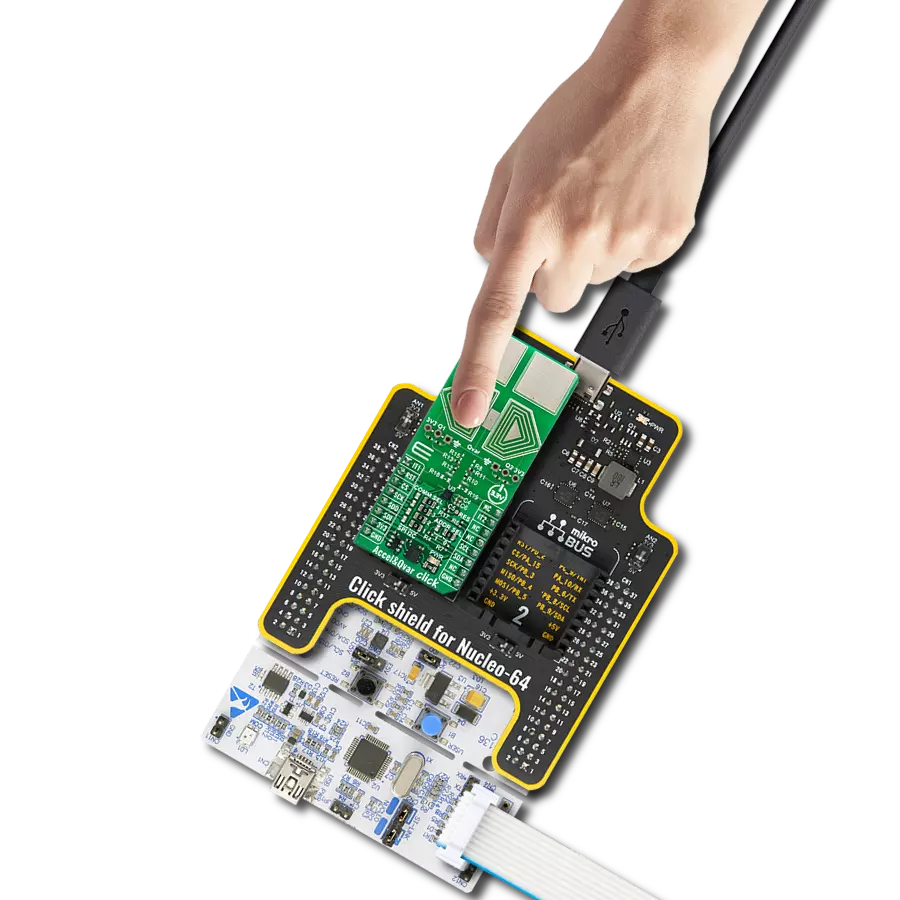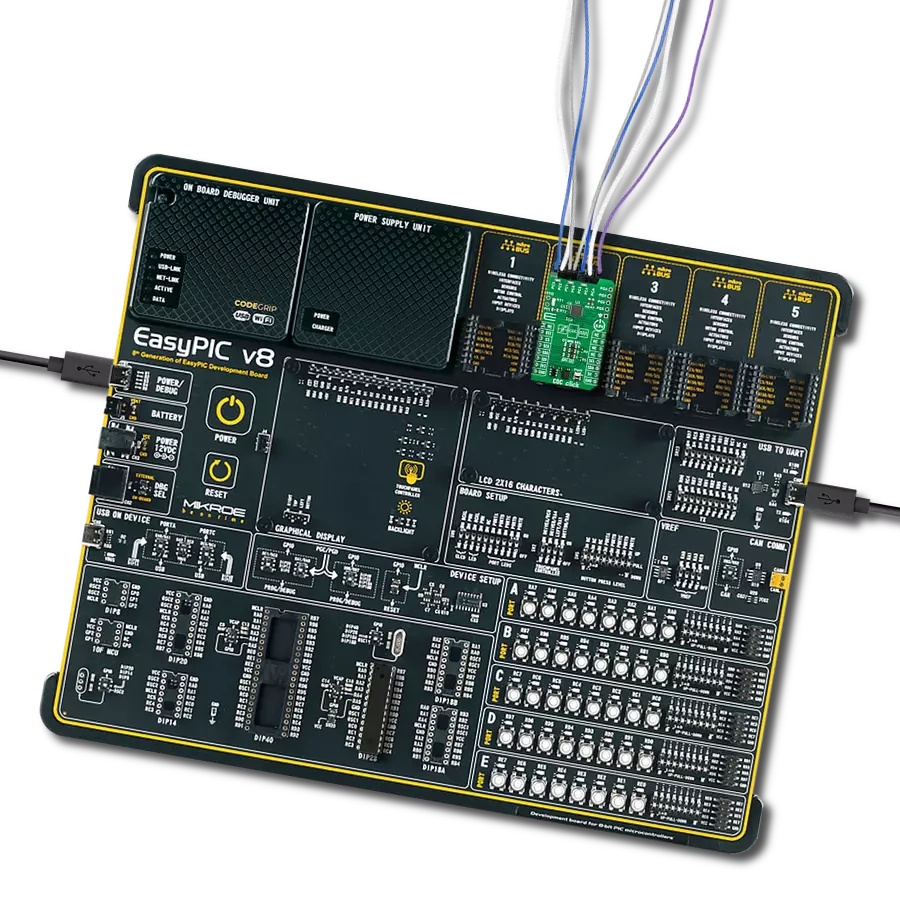Shape the future of interaction and engineer solutions that captivate and empower users
A
A
Hardware Overview
How does it work?
Cap Extend Click is based on the SX8633, a low-power capacitive button touch controller with enhanced LED drivers and proximity sensing from Semtech. It is a fully integrated 12-channel solution that requires no external components. The SX8633 IC has a 10-bit ADC and up to 100pF offset capacitance compensation at full sensitivity. Thanks to the high resolution, it supports a wide variety of touchpad sizes and shapes to be used with this Click board™. An overlay material up to 5mm thick can also be used for extremely robust ESD immune system design, simplifying integration into touch panels, control units, and similar applications. The SX8633 features auto offset calibration to eliminate false triggers due to temperature and humidity and is initiated on power-up. The principle of touch buttons and proximity sensing operation is almost identical. The only difference is that proximity sensing is done several centimeters through the air above the overlay, while as a button, it has an ON state if
a finger or hand touches it and OFF if it is far from the sensor. The Analog Sensing Interface (ASI) converts the sensors' charge into digitally processed ticks in both applications. The ASI consists of an ADC, DAC, multiplexer, analog switches, a reference voltage, and an external integration capacitor. In LED applications, the Auto-light mode can initiate the LED fade effect individually for each GPIO, with 256 PWM steps of linear and logarithmic control. The SX8633 has three operating modes. The Active mode has fast scan periods with a typical reaction time of up to 30ms, in which interval all enabled sensors are scanned, and data is processed. The Doze mode can increase scan period time, thus and the reaction time up to 195ms. In Sleep mode, the SX8633 goes OFF except for the communication interface and GPI peripheral, at which time it does not do any sensor scanning. Users can manipulate those scan periods for Active and Doze modes in relation to power consumption. To enter the Active
mode from Doze, the user can simply touch any button. The Cap Extend Click uses an I2C 2-Wire interface in standard and fast mode with a maximum clock frequency of 400KHz to communicate with the host microcontroller. The interrupt INT pin is also available and is updated in Active or Doze once every scan period. The interrupt will be asserted when a button event or a GPI edge occurs when entering Active or Doze and will be cleared as soon as the host MCU performs a read. In addition, there is an RST pin for resetting the SX8633 with active LOW. This Click board™ can be operated only with a 3.3V logic voltage level. The board must perform appropriate logic voltage level conversion before using MCUs with different logic levels. Also, it comes equipped with a library containing functions and an example code that can be used, as a reference, for further development.
Features overview
Development board
Nucleo-64 with STM32G071RB MCU offers a cost-effective and adaptable platform for developers to explore new ideas and prototype their designs. This board harnesses the versatility of the STM32 microcontroller, enabling users to select the optimal balance of performance and power consumption for their projects. It accommodates the STM32 microcontroller in the LQFP64 package and includes essential components such as a user LED, which doubles as an ARDUINO® signal, alongside user and reset push-buttons, and a 32.768kHz crystal oscillator for precise timing operations. Designed with expansion and flexibility in mind, the Nucleo-64 board features an ARDUINO® Uno V3 expansion connector and ST morpho extension pin
headers, granting complete access to the STM32's I/Os for comprehensive project integration. Power supply options are adaptable, supporting ST-LINK USB VBUS or external power sources, ensuring adaptability in various development environments. The board also has an on-board ST-LINK debugger/programmer with USB re-enumeration capability, simplifying the programming and debugging process. Moreover, the board is designed to simplify advanced development with its external SMPS for efficient Vcore logic supply, support for USB Device full speed or USB SNK/UFP full speed, and built-in cryptographic features, enhancing both the power efficiency and security of projects. Additional connectivity is
provided through dedicated connectors for external SMPS experimentation, a USB connector for the ST-LINK, and a MIPI® debug connector, expanding the possibilities for hardware interfacing and experimentation. Developers will find extensive support through comprehensive free software libraries and examples, courtesy of the STM32Cube MCU Package. This, combined with compatibility with a wide array of Integrated Development Environments (IDEs), including IAR Embedded Workbench®, MDK-ARM, and STM32CubeIDE, ensures a smooth and efficient development experience, allowing users to fully leverage the capabilities of the Nucleo-64 board in their projects.
Microcontroller Overview
MCU Card / MCU
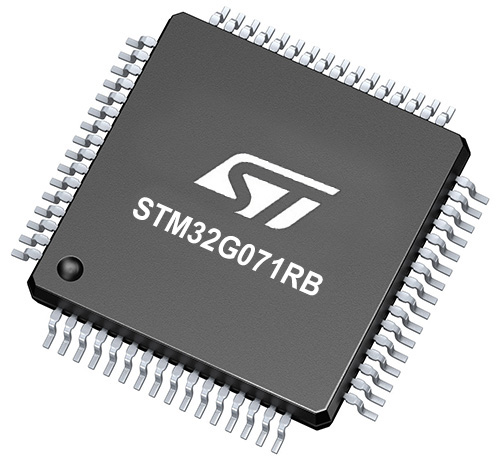
Architecture
ARM Cortex-M0
MCU Memory (KB)
128
Silicon Vendor
STMicroelectronics
Pin count
64
RAM (Bytes)
36864
You complete me!
Accessories
Click Shield for Nucleo-64 comes equipped with two proprietary mikroBUS™ sockets, allowing all the Click board™ devices to be interfaced with the STM32 Nucleo-64 board with no effort. This way, Mikroe allows its users to add any functionality from our ever-growing range of Click boards™, such as WiFi, GSM, GPS, Bluetooth, ZigBee, environmental sensors, LEDs, speech recognition, motor control, movement sensors, and many more. More than 1537 Click boards™, which can be stacked and integrated, are at your disposal. The STM32 Nucleo-64 boards are based on the microcontrollers in 64-pin packages, a 32-bit MCU with an ARM Cortex M4 processor operating at 84MHz, 512Kb Flash, and 96KB SRAM, divided into two regions where the top section represents the ST-Link/V2 debugger and programmer while the bottom section of the board is an actual development board. These boards are controlled and powered conveniently through a USB connection to program and efficiently debug the Nucleo-64 board out of the box, with an additional USB cable connected to the USB mini port on the board. Most of the STM32 microcontroller pins are brought to the IO pins on the left and right edge of the board, which are then connected to two existing mikroBUS™ sockets. This Click Shield also has several switches that perform functions such as selecting the logic levels of analog signals on mikroBUS™ sockets and selecting logic voltage levels of the mikroBUS™ sockets themselves. Besides, the user is offered the possibility of using any Click board™ with the help of existing bidirectional level-shifting voltage translators, regardless of whether the Click board™ operates at a 3.3V or 5V logic voltage level. Once you connect the STM32 Nucleo-64 board with our Click Shield for Nucleo-64, you can access hundreds of Click boards™, working with 3.3V or 5V logic voltage levels.
Used MCU Pins
mikroBUS™ mapper
Take a closer look
Click board™ Schematic

Step by step
Project assembly
Software Support
Library Description
This library contains API for Cap Extend Click driver.
Key functions:
capextend_reset- This function does a software reset of the click modulecapextend_read_msb_buttons- This function reads the MSB button map datacapextend_read_lsb_buttons- This function reads the LSB button map data
Open Source
Code example
The complete application code and a ready-to-use project are available through the NECTO Studio Package Manager for direct installation in the NECTO Studio. The application code can also be found on the MIKROE GitHub account.
/*!
* \file
* \brief CapExtend Click example
*
* # Description
* This example showcases the initialization and configuration of the logger and Click modules
* and later on shows how to read and display the 16-bit button map ( LSB + MSB ).
*
* The demo application is composed of two sections :
*
* ## Application Init
* This function initializes and configures the Click and logger modules.
*
* ## Application Task
* This function collects map data and displays the 16-bit button map, where each bit that has
* the value 1 represents a button that has been pressed.
*
* \author MikroE Team
*
*/
// ------------------------------------------------------------------- INCLUDES
#include "board.h"
#include "log.h"
#include "capextend.h"
// ------------------------------------------------------------------ VARIABLES
static capextend_t capextend;
static log_t logger;
// ------------------------------------------------------ APPLICATION FUNCTIONS
void application_init ( )
{
log_cfg_t log_cfg;
capextend_cfg_t cfg;
/**
* Logger initialization.
* Default baud rate: 115200
* Default log level: LOG_LEVEL_DEBUG
* @note If USB_UART_RX and USB_UART_TX
* are defined as HAL_PIN_NC, you will
* need to define them manually for log to work.
* See @b LOG_MAP_USB_UART macro definition for detailed explanation.
*/
LOG_MAP_USB_UART( log_cfg );
log_init( &logger, &log_cfg );
log_info( &logger, "---- Application Init ----" );
// Click initialization.
capextend_cfg_setup( &cfg );
CAPEXTEND_MAP_MIKROBUS( cfg, MIKROBUS_1 );
capextend_init( &capextend, &cfg );
capextend_reset( &capextend );
}
void application_task ( )
{
uint16_t buttons = 0;
buttons = capextend_read_buttons( &capextend );
log_printf( &logger, " * ---------BUTTTONS--------- * \r\n" );
for ( uint8_t counter = 0; counter < 12; counter++ )
{
if ( ( buttons >> ( 11 - counter ) ) & 1 )
{
log_printf( &logger, " * " );
}
else
{
log_printf( &logger, " o " );
}
}
log_printf( &logger, "\r\n * ------------------------------- * \r\n\r\n" );
Delay_ms ( 500 );
}
int main ( void )
{
/* Do not remove this line or clock might not be set correctly. */
#ifdef PREINIT_SUPPORTED
preinit();
#endif
application_init( );
for ( ; ; )
{
application_task( );
}
return 0;
}
// ------------------------------------------------------------------------ END
Additional Support
Resources
Category:Capacitive



















